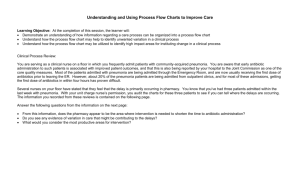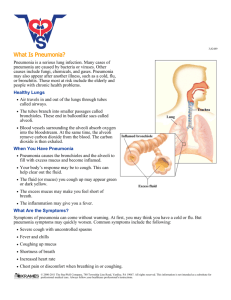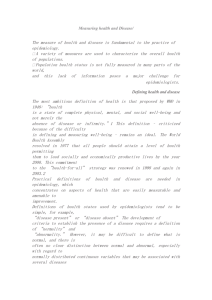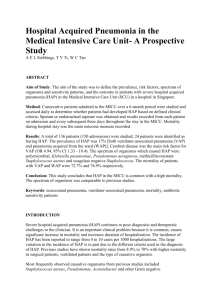pneumonia (hap, cap
advertisement
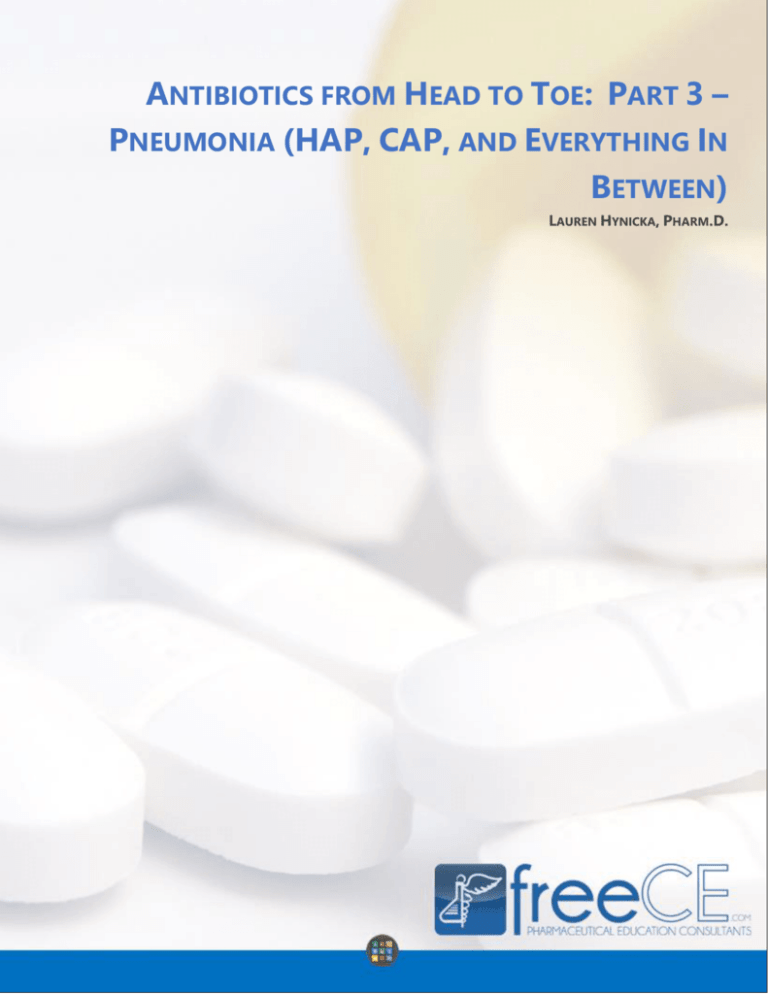
ANTIBIOTICS FROM HEAD TO TOE: PART 3 – PNEUMONIA (HAP, CAP, AND EVERYTHING IN BETWEEN) LAUREN HYNICKA, PHARM.D. ANTIBIOTICS FROM HEAD TO TOE: PART 3 – PNEUMONIA (HAP, CAP, AND EVERYTHING IN BETWEEN ACTIVITY DESCRIPTION ACCREDITATION Antibiotic use in the safest and most efficacious manor possible is critically important for multiple reasons. Appropriate antibiotic use decreases the morbidity and mortality associated with infectious diseases. However, in an era where antibiotic resistance is becoming increasingly more problematic, this must be balanced with judicious use to preserve antibiotic effectiveness. In the series titled, "Antibiotics from Head to Toe" we will review appropriate antibiotic use by disease state. PHARMACY PharmCon, Inc. is accredited by the Accreditation Council for Pharmacy Education as a provider of continuing pharmacy education. NURSING PharmCon, Inc. is approved by the California Board of Registered Nursing (Provider Number CEP 13649) and the Florida Board of Nursing (Provider Number 503515). Activities approved by the CA BRN and the FL BN are accepted by most State Boards of Nursing. TARGET AUDIENCE The target audience for this activity is pharmacists and pharmacy technicians in hospital, community, and retail pharmacy settings. CE hours provided by PharmCon, Inc. meet the ANCC criteria for formally approved continuing education hours. The ACPE is listed by the AANP as an acceptable, accredited continuing education organization for applicants seeking renewal through continuing education credit. For additional information, please visit http://www.nursecredentialing.org/RenewalRequirements.aspx LEARNING OBJECTIVES After completing this activity, the pharmacist will be able to: Define community acquired pneumonia (CAP), hospital acquired pneumonia (HAP), ventilator associated pneumonia (VAP) and healthcare associated pneumonia (HCAP) Identify the most common organisms seen in CAP, HAP, VAP and HCAP Select appropriate empiric antibiotic therapy for a patient with pneumonia After completing this activity, the pharmacy technician will be able to: Identify the symptoms of pneumonia List ways to treat pneumonia Universal Activity No.: 0798-0000-13-210-H01-P&T Credits: 1 contact hour (0.1 CEU) Release Date: June 3, 2014 Expiration Date: June 3, 2016 ACTIVITY TYPE Knowledge-Based, Home-Study Webcast FINANCIAL SUPPORT BY Pharmaceutical Education Consultants, Inc. 1 ABOUT THE AUTHOR Dr. Hynicka is an assistant professor of pharmacotherapy at the University of Maryland School of Pharmacy and serves as a clinical pharmacy specialist on a general internal medicine team at the University of Maryland Medical Center. She received her doctor of pharmacy degree from the University of Pittsburgh School of Pharmacy in Pittsburgh, PA. She then completed residencies in Pharmacy Practice and Internal Medicine at the Virginia Commonwealth University Health System in Richmond,VA. In addition to her areas of practice, her other interests include infectious disease, immunology, hepatology, pharmacoeconomics and pharmacogenomics. Lauren Hynicka, PharmD Assistant Professor, University of Maryland School of Pharmacy FACULTY DISCLOSURE It is the policy of PharmCon, Inc. to require the disclosure of the existence of any significant financial interest or any other relationship a faculty member or a sponsor has with the manufacturer of any commercial product(s) and/or service(s) discussed in an educational activity. Lauren Hynicka reports no actual or potential conflict of interest in relation to this activity. Peer review of the material in this CE activity was conducted to assess and resolve potential conflict of interest. Reviewers unanimously found that the activity is fair balanced and lacks commercial bias. Please Note: PharmCon, Inc. does not view the existence of relationships as an implication of bias or that the value of the material is decreased. The content of the activity was planned to be balanced and objective. Occasionally, authors may express opinions that represent their own viewpoint. Participants have an implied responsibility to use the newly acquired information to enhance patient outcomes and their own professional development. The information presented in this activity is not meant to serve as a guideline for patient or pharmacy management. Conclusions drawn by participants should be derived from objective analysis of scientific data presented from this monograph and other unrelated sources. 2 3 4 5 6 7 8 9 10 ACTIVITY TEST 1. Please use the following case to answer the next 3 questions. PL is a 53 yo Caucasian male who presents to his PCP’s office (Dr. Smith) with a chief complaint of shortness of breath (SOB) and cough x 3 days. PL has no significant PMH, has never required hospitalization and does not take any medications. A chest x-ray is obtained and shows an infiltrate in the right lower lobe. You are working at CVS when you get a call from Dr. Smith about PL’s case. Dr. Smith provides you with the information above and believes PL is a candidate for outpatient treatment of his community acquired pneumonia (CAP). What additional information will you ask Dr. Smith for to help determine how PL should be triaged? A. Mental status exam, Uremia, respiratory rate, blood pressure B. Mental status exam, BUN, respiratory rate, blood pressure C. Mental status exam, serum creatinine, respiratory rate, blood pressure D. Mental status exam, serum ammonia, respiratory rate, blood pressure 2. After you obtain the additional information from Dr. Smith you determine PL is an appropriate candidate to receive outpatient treatment. Dr. Smith agrees and you begin to discuss the organisms most likely to have caused PL’s infection. Dr. Smith recalls that streptococcus pneumoniae is a common organism in this patient population. Which other organisms are among the most common causes of CAP in this patient population? A. Atypical organisms, haemophilus influenzae and respiratory viruses B. Atypical organisms, haemophilus influenzae and staphylococcus aureus C. Atypical organisms, staphylococcus aureus and gram negative bacilli D. Atypical organisms, haemophilus influenzae and gram negative bacilli 3. Based on your knowledge of the likely infecting pathogens, the IDSA guideline recommendations for specific patient populations and the treatment location, please select the antibiotic regimen that would be most appropriate to recommend to Dr. Smith for the treat PL’s CAP. (HINT: Assume low rates of macrolide resistant s. pneumo). A. Azithromycin B. Ceftriaxone + Azithromycin C. Levofloxacin + Azithromycin D. Levoflaxacin 11 4. RD is a 49 yo AAF with a PMH significant for end stage renal disease secondary to uncontrolled hypertension who received hemodialysis 3 days a week. She presents to the ED with a history of shortness of breath and subjective fever for the last 24 hours. You are suspicious for pneumonia. Which of the following types of pneumonia does RD likely have? A. CAP B. HCAP C. HAP D. VAP 5. What organism(s) are most likely to cause RD’s pneumonia? A. Respiratory virus B. Fungi C. Anaerobes D. Aerobic gram-negative bacilli 6. Which of the following are considered minor criteria when determining severity of illness for a patient with CAP? A. Multilobar infiltrates B. Leukopenia C. Thrombocytopenia D. All of the above 7. Additional testing is recommended for patients with HAP/VAP. Which additional testing should be done for ALL patients with HAP? A. Blood cultures B. Legionella urine antigen testing C. Lower respiratory secretion culture D. All of the above 8. Immunizations have been shown to decrease risk of pneumonia. Which immunizations are most beneficial in reducing a patient’s risk for pneumonia? A. Herpes zoster vaccine B. Pneumococcal vaccine C. Influenza vaccine D. A and C E. B and C 9. Which of the following fluoroquinolones is NOT considered a respiratory fluoroquinolone and therefore should NOT be used as empiric therapy for CAP? A. Ciprofloxacin B. Levofloxacin C. Moxifloxacin D. Avelox 12 10. Risk for MRSA pneumonia is increasing. Daptomycin should NOT be used in the treatment of a patient suspected of having MRSA pneumonia because of which of the following reasons? A. Daptomycin only covers MSSA B. Daptomycin is inactivated by lung surfactants C. Daptomycin is unable to penetrate into the lungs D. Daptomycin can be used to treat MRS pneumonia Please submit your final responses on freeCE.com. Thank you. 13

